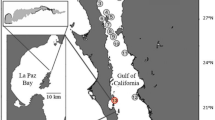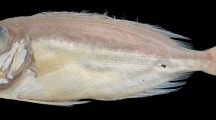Abstract
The shrimp species Pandalus montagui is known for its seasonal, vertical migration due to its reproductive cycle. Previous work indicates that horizontal migration of this species is also evident. At the German Bight (North Sea), we observed possible offspring from its main population at the Helgoland Trench (HTR) inside Jade Bay. Samples were taken at different stations in Jade Bay and in the HTR. Alongside the measurement of the individual carapace lengths, the genders of P. montagui have been determined in order to compare both Jade Bay and HTR specimens according to their size and gender distributions. The results show a limited occurrence of P. montagui, mostly females, in Jade Bay, with a size distribution that broadly matches the size of the individuals from the HTR. These observations imply that, in the summer months especially, Jade Bay appears to be a suitable habitat for individuals of P. montagui not taking part in the reproductive cycle, as the animals of this small population offset are too young. As shown in earlier studies, it can be confirmed that females are generally larger than males at the same age.





Similar content being viewed by others
References
Allen JA (1963) Observations on the biology of Pandalus montagui [Crustacea: Decapoda]. J Mar Biol Assoc UK 43:665–682
Balss H (1930) Wanderungen bei Decapoden (Crustaceen). Ergebn Biol 6:305–326
Becker GA (1990) Die Nordsee als physikalisches system. In: Lozán JL, Lenz W, Rachor E, Watermann B, von Westernhagen H (eds) Warnsignale aus der Nordsee: Wissenschaftliche Fakten. Parey, Berlin, Hamburg, pp 11–28
Bergström BI (2000) The biology of Pandalus. In: Southward AJ, Tyler PA, Young CM, Fuiman L (eds) Advances in marine biology, vol 38. Academic Press, London/San Diego, pp 55–245
Berkeley AA (1931) The post-embryonic development of the common Pandalids of British Columbia. Contrib Can Biol Fish 6:79–163
Blahudka S, Türkay M (2002) A population study of the shrimp Crangon allmanni in the German Bight. Helgol Mar Res 56:190–197
Dörjes J (1969) Das Untersuchungsgebiet. Lage und Gliederung. Senckenb Marit 1:50
Ehmisch M (2007) Populationsbiologie und Lebenszyklus von Pandalus montagui (LEACH, 1814) in der Helgoländer Tiefen Rinne. State examination thesis, J. W. Goethe-University, Frankfurt am Main, pp 1–442
Hesemann H (1995) Tageszeitliche Feinauflösung des Auftretens von Decapodenlarven im Plankton der Innenjade. Methodische Ansätze und ökologische Implikationen. Diploma thesis, Department of Biology, J. W. Goethe-University, Frankfurt am Main, pp 1–162
Jennings S, Lancaster J, Woolmer A, Cotter J (1999) Distribution, diversity and abundance of epibenthic fauna in the North Sea. J Mar Biol Assoc UK 79:385–399
Kemp S (1910) The Decapoda Natantia of the coasts of Ireland. Fisheries, Ireland, Sci Invest 1 (1908)
Leach WE (1813, 1814) Crustaceology. Brewster’s Edinburgh Encyclopedia, E. Routledge: London. 7:383–384 (1813); 385–437, pl. 14 (1814)
Leloup E (1936) Les transformations des gonades et des caractères sexuels externes chez Pandalus montagui LEACH (Décapode). Bull Mus Hist Nat Belg 12(19):1–27
Mistakidis MN (1957) The biology of Pandalus montagui LEACH. Fish Investig 21(2):4
Murie J (1903) Report on the sea fisheries and fishing industries of the Thames Estuary. Waterlow Bros. & Layton, London
R Development Core Team (2008) R: a language and environment for statistical computing. R Foundation for Statistical Computing, Vienna
Schwinn M, Türkay M, Sonnewald M (2014) Decapod fauna of the Helgoland trench (Crustacea) a long-term study in a biodiversity hotspot. Mar Biodivers 44:491–517. doi:10.1007/s12526-014-0217-4
Smaldon G, Holthuis LB, Fransen CHJM (1993) Coastal shrimps and prawns. Synopses of the British Fauna (new series). Linnaean Society of London and the Estuarine and Coastal Sciences Association 15 (2nd edn), pp 1–142
Trepte I (1991) Tages- und Tideperiodische Variabilität des Auftretens von Decapoden-Larven in der Jade (südliche Nordsee). Diploma thesis, Department of Biology, J. W. Goethe-University, Frankfurt am Main, pp 1–85
Warren PJ, Sheldon RW (1967) Feeding and migration patterns of the pink shrimp, Pandalus montagui, in the estuary of the River Crouch, Essex, England. J Fish Res Board Can 24(3):569–580
Wolf F (1991) Unterschungen zur Dekapodenlarvenfauna der Jade. Diploma thesis, Department of Biology, J. W. Goethe-University, Frankfurt am Main, pp 1–146
Acknowledgments
The authors would like to acknowledge all colleagues of the crustacean department at the Senckenberg Institute (Frankfurt am Main) and thank them for their support. Furthermore, we would like to thank the members of the project ‘Hydro-Jade’ performed by the department of Marine Sedimentology at Senckenberg by the Sea (Wilhelmshaven), who provided important temperature and salinity data.
Moreover, we especially thank Dr. Ingrid Kröncke and Dr. Ulrike Schückel from Senckenberg by the Sea in Wilhelmshaven, who provided abundant data of caught individuals of P. montagui in Jade Bay.
Not least of all, we also thank the crew and captains of the research cutter FK Senckenberg, enabling us to conduct this study with excellent working conditions at sea.
Authors’ contributions
Maike Sabel carried out the studies and drafted the manuscript. Michael Türkay conceived and supervised the study. Moritz Sonnewald participated in the design of the study and coordinated and helped to draft the manuscript. All authors read and approved the final manuscript.
Author information
Authors and Affiliations
Corresponding author
Ethics declarations
Conflict of interest
The authors declare that they have no competing interests.
Additional information
Communicated by S. De Grave
Rights and permissions
About this article
Cite this article
Sabel, M., Türkay, M. & Sonnewald, M. Population analysis of the pink shrimp Pandalus montagui Leach, 1814 (Crustacea: Pandalidae) in Jade Bay (North Sea) indicates a link to the population at the Helgoland Trench. Mar Biodiv 47, 913–919 (2017). https://doi.org/10.1007/s12526-016-0524-z
Received:
Revised:
Accepted:
Published:
Issue Date:
DOI: https://doi.org/10.1007/s12526-016-0524-z




